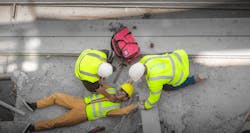Several months ago, I commissioned a feature article about jobsite safety to shine a light on a critical aspect of our industry that has a personal, financial, and reputational impact on every builder and subcontractor out there.
The article, which appeared in our July/August 2022 issue, is great. Senior contributing editor John Caulfield combines recent real-world and specific data about accidents on residential construction sites that lead to tragic and costly injuries and deaths (including suicide) in the course of building houses, with anecdotal insights from home builders and safety experts about practical preventive measures to alleviate such incidents. Good stuff; the stuff every builder can use right now. I hope you do.
We have a labor problem in our industry, and it’s not just numbers.
But amid that stuff are tales of field superintendents emptying a site to avoid a safety inspection that would likely result in violations and fines; of crews putting on a show for a safety review only to revert back to lax policies and enforcement once the “heat” is off; and of workers and subcontractors jumping from a safety-conscious builder to one that isn’t so (or at all) diligent in that regard so they can “do their jobs without impairment.”
Seriously? For all of the talk about “safety first” in our industry, I doubt it actually breaks the Top 10 on most residential jobsites, falling by the wayside to “efficiency,” “profitability,” “maintaining the schedule,” and a handful of other concerns that are no less real but also aren’t as life-threatening or life-taking as a 30-foot fall from a roof, getting buried in a trench, inhaling silica dust all day, taking a steel beam to the head, or succumbing to heat stroke, dehydration, or emotional desperation.
RELATED
- Construction Worker Suicide: A Fragile Balance
- Excavation and Trench Safety Best Practices for Construction Jobsites
- Construction Site Fall Protection Made Simple
- Safe Scaffolding: Follow These Best Practices for Correct Setup
Statistics Show Construction Is Among the Most Dangerous Jobs
No wonder roofers and construction helpers rank third and fourth, respectively, among the most dangerous jobs in the U.S., with construction supervisors (No. 13) and workers (No. 19) also in the mix. No wonder the comments on our video about housing’s skilled labor shortage were dominated by complaints about builders and specialty trade company owners who couldn’t care less about on-site worker safety and well-being. No wonder builders can’t find workers.
We have a labor problem in our industry, and it’s not just numbers. What your crews and subs do is dangerous work, performed outdoors in sometimes inclement or extreme weather conditions, using unforgiving tools, equipment, and materials, suffering the stress of a tight schedule and a narrow margin of financial stability and job security … the list goes on.
Yes, they need training and the right gear to work safely; that’s a given—or at least it should be. But what these workers really need is a company that truly cares about their welfare and is willing to sincerely put safety first, instead of last.
About the Author

Rich Binsacca, Head of Content
Rich Binsacca is Head of Content of Pro Builder and Custom Builder media brands. He has reported and written about all aspects of the housing industry since 1987 and most recently was editor-in-chief of Pro Builder Media. [email protected]
